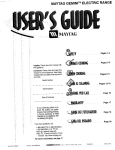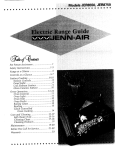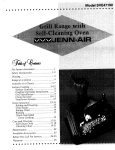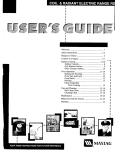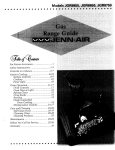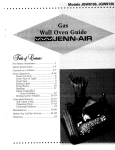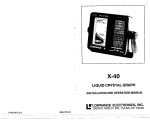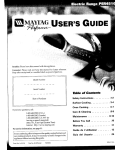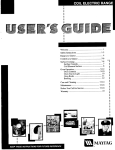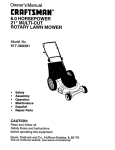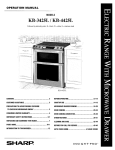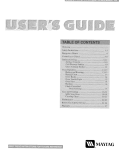Download Jenn-Air JER8650 User's Manual
Transcript
For Future Assistance
Safety Instructions
..............................
...............................
I
1-3
Range at a Glance ...................................
4
Controls at a Glance ............................ 5-7
Surface Cooking ..................................
8-10
Surface Controls .................................
8
Panel Light ..........................................
9
Coil Element Surface ......................... 9
Glass-Ceramic Surface .................... 10
Oven Operation ................................ 11-17
Oven Controls ..................................
Ii
Baking Chart ....................................
12
Oven Vent & Light ........................... 13
Oven Racks ......................................
13
Broiling .............................................
14
Clock Controlled
Oven Cooking ............................. I5
Drying ..........................................
16-17
Care and Cleaning ...........................
18-22
Self- Clean Oven .......................... 18-19
Cleaning Chart ........................... 20-22
Cleaning Products ............................ 22
Maintenance
....................................
23-24
Before You Call ,for Service .............. 25-26
Warranty
................................................
27
] For Future Assistance
•
•
•
•
•
•
•
•
•
•
•
•
•
•
•
•
•
•
•
•
•
•
Congratulations on your choice of a Jenn-Air electric range.
In addition, you will find a booklet entitled "Cooking Made
Simple."
It contains
information
on selecting
provides baking,
roasting
and broiling
tips. cookware and
Save time and money. Check the "Before You Call" section
of this guide. It lists causes of minor operating problems that
you can correct yourself.
•
•
•
•
•
•
•
•
IMPORTANT
Your complete satisfaction is very important to us.
Read this user's guide carefully. It is intended to help you
operate and maintain your new range,
•
•
•
•
•
•
•
•
SAFETY
INSTRUCTIONS
Read and follow all instructions before using this app|ianee to prevent the potential risk of fire, electric shock,
personal injury or damage to the appliance as a result of
improper usage of the appliance. Use appliance only for
its intended purpose as described in this guide.
To ensure proper and safe operation: Appliance must
be properly installed and grounded by a qualified techniclan.
However, should you need service, it is helpful to have the
model and serial numbers available. This information can be
found on the data plate located on the storage drawer frame.
i
ALL RANGES CAN TIP AND
CAUSE INJURIES TO
PERSONS
These numbers are also on the Product Registration card that
came with your appliance. Before sending in this card, record
these numbers along with the purchase date below.
_
I
PACKEDWITH RANGE
• FOLLOWALL INSTALLATION
• INSTRUCTIONS
INSTALLANTI-TIP DEVICE
Model Number
Serial Number
Date of Purchase
AWA.N,NG
WARNING: To reduce risk of tipping of the appliance
from abnormal usage or by excessive loading of the oven
door, the appliance must be secure by a properly installed
anti-tip device.
To check if device is properly installed, remove storage
drawer and look underneath range to make sure one of the
rear leveling legs is properly engaged in the bracket slot.
The anti-tip device secures the rear leveling leg to the floor
when properly engaged. You should check this anytime
the range has been moved.
IMPORTANT: Keep this guide and the sales receipt in a
safe place for future reference. Proof of original purchase
In Case o[ Fire
date is needed for warranty service.
Turn off appliance and ventilating hood to avoid spreading the flame. Extinguish flame then turn on hood to remove smoke and odor.
If you have questions, write us (include your model number
and phone number) or call:
Consumer Information
403 West Fourth Street North
Newton, IA 50208
515-787-8911
(Mon. - Fri., 8 am-5 pm Central Time)
Internet: http://www.jennair.com
For service information, see page 26.
in a pan with a lid or cookie
sheet.
• Cooktop: Smother fire or flame
NEVER pick up or move a
flaming pan.
• Oven: Smother fire or flame by closing the oven door.
Do not use water on grease fires. Use baking soda, a dry
chemical or foam type extinguisher to smother fire or
flame.
•
•
•
•
•
•
•
•
•
•
•
•
•
•
•
•
•
•
Important
•
•
•
•
General Instructions
or seat as this may result in possible tipping of the appliance, damage to the ap-
•
•
•
•
Safety Instructions
•
•
•
•
•
•
•
•
•
•
•
•
•
•
•
•
Cooktop
"_t
i.,_
unattended boilover could cause smoking
and a greasy spillover can cause a fire.
°
door,
or drawer,
if equipped,
as a step stool t_
I
pliance,
and serious
injuries.
If appliance
is installed
near a window,
proper precautions should be taken to pre- __e_,_-*'_._
vent curtains from blowing over surface
pecially
when using
high heat
settings. An
This
appliance
is equipped
size surface
elements.
Selectwith
pansdifferent
having
flat bottoms large enough to cover element. Proper relationship of pan to element
NEVER use appliance to warm or heat
the room. Failure to follow this instruction
can lead to possible bums, injury, fire, _
elements.
or damage to the appliance.
_,_#_*_.._.
NEVER wear loose-fitting or hanging __"-l_m3Li_i_
""
-_
garments while using the appliance. 'I_,t _.._
If pan is smaller than element, a portion
of the element will be exposed to direct
contact
and cooking
could ignite
clothing or
will improve
efficiency.
potholder.
Only certain types of glass, glass/ceramic, ceramic, earthenware, or other glazed utensils are suitable for cooktop or oven
ignite andcould
cause catch
burnsutensil
if garment
comes
Clothing
handles
or _
in contact with hot heating elements,
perature.
Follow breaking
utensil manufacturer's
instructions
usservice without
due to the sudden
changewhen
in teming glass.
To ensure proper operation and to avoid damage to the appliance or possible injury, do not adjust, service, repair or
replace any part of the appliance unless specifically recommended in this guide. Refer all other servicing to a qualified
technician,
Turn pan handle toward center of cooktop,
not out into the room or over another surface element. This reduces the risk of
burns, ignition of flammable materials, or
spillage if pan is accidently bumped or
NEVER store or use gasoline or other combustible or flammable materials in the oven, near surface units or in the vicinity of this appliance as fumes could create a fire hazard
or an explosion,
reached by small children.
_P"
To prevent damage to removable heating elements, do not
immerse, soak or clean in a dishwasher or self-clean oven. A
damaged element could short resulting in a fire or shock
To prevent grease fires, do not let cooking grease or other
flammable materials accumulate in or near the appliance.
hazard.
Make sure drip bowls are in place as absence of these bowls
Use only dry potholders. Moist or damp
_#_
potholders on hot surfaces may result ___
during cooking could damage wiring. (select models)
in a steam
burn. Do
not letDo
potholder
touch
hot heating
elements.
not use .o....
a towel or other bulky cloth which could __?*,,_, ....
easily touch hot heating elements and r
ignite,
.
_
_'**_'
_
__
_i
A_#_
_
_,
'
Glass-Ceramic Cooktop {select models)
'
Always turn off all controls when cooking is completed,
NEVER cook on broken cooktop. If cooktop should break,
cleaning solutions and spillovers may penetrate the broken
cooktop and create a risk of electric shock. Contact a quailfled technician immediately.
NEVER heat unopened containers on the surface unit or in
the oven. Pressure build-up in the container may cause container to burst resulting in bums, injury or damage to the
appliance,
Clean cooktop with caution. Some cleaners can produce noxious fumes if applied to a hot surface. If a wet sponge, cloth,
or paper towel is used to wipe spills on a hot cooking area,
be careful to avoid steam burn.
NEVER use aluminum foil to line drip bowls, or to cover
an electric
oven rack
or oven
Misuse
could
result inUse
riskfoil
of
shock,
fire,bottom.
or damage
to the
appliance.
Deep Fat Fryers
only as directed in this guide.
Use extreme caution when moving the grease pan or disposing of hot grease. Allow grease to cool before attempting to
move pan.
Important
•
•
•
•
•
•
•
•
•
•
Safety Instructions
•
•
•
•
•
•
•
Oven
•
•
•
•
•
•
•
•
•
•
•
•
•
•
•
•
•
•
•
•
•
•
"Eih,Child Safety
Use care when opening door. Let hot air
or steam escape before removing or replacing food.
NEVER leave children alone or unsupervised in area where appliance is in use or
is still hot.
_i_
: _"_
For
proper
oven
operation
obstruct
oven
vent
duct. and performance, do not block or
NEVER
allow
children toassit
or stand
any part of
the appliance
they
could on
be
_i_
i,_J_!_llo_i!ii_
_,_'_•
Always place oven racks in desired locations while oven is
injured or burned.
_ I_-_ll
cool.
If rack
musthot
be heating
moved element
while oven
is hot, do not let
potholder
contact
in oven.
CAUTION:
NEVER
store above
items an
of apin- .__
terest to children
in cabinets
pliance or on backguard of a range. Chil'--'_'_'_....
dren climbing on appliance, door or drawer to reach items
could damage the appliance or be burned or seriously injured.
Self-Cleaning Oven
s_
Clean only parts listed in this guide. Do not clean door gasket. The gasket is essential for a good seal. Care should be
Children must be taught that the appliance and utensils in or
on it can be hot. Let hot utensils cool in a safe place, out of
taken not to rub, damage, or move the
gasket.
_ _
_l_"::i!i_
reach of small children. Children should be taught that an
appliance is not a toy. Children should not be allowed to
oven cleaner or oven liner protective coatDo not use oven cleaners. No commercial
ing of any kind should be used in or around
any part of the oven.
!
iU_J
_t_i_
_"_
_
_!
play with controls or other parts of the unit.
Ventilating
Hoods
Before self-cleaning the oven, remove broiler pan, oven racks
and other utensils to prevent excessive smoking, discoloration of the oven racks or possible damage to utensils.
Clean range hood and filters frequently to prevent grease or
other flammable materials from accumulating on hood or
filter and to avoid grease fires.
Wipe up excessive spillovers, especially greasy spills, before the clean cycle to prevent smoking or flare-ups,
It is normal for the cooktop to become hot during a clean
cycle. Therefore, avoid touching or lifting the cooktop dur-
Turn the fan off when flamb6ing foods (such as Cherry Jubilee) under the hood. The fan, if operating, may spread the
flame.
ing a clean cycle.
Important Safety Notice and Warning
Heating Elements
The California Safe Drinking Water and Toxic Enforcement
Act of 1986 (Proposition 65) requires the Governor of California to publish a list of substances known to the State of
California to cause cancer or reproductive harm, and requires
businesses to warn customers of potential exposures to such
substances.
NEVER touch surface or oven heating elements, areas
near elements, or interior surfaces of oven.
Heating elements may be hot even though they are dark in
color. Areas near surface elements and interior surfaces of
an oven may become hot enough to cause burns. During and
after use, do not touch or let clothing or other flammable
materials contact heating elements, areas near elements, or
interior surfaces of oven until they have had sufficient time
to cool.
Other potentially hot surfaces include: Cooktop, areas facing the cooktop, oven vent, and surfaces near the vent opening, oven door, areas around the door and oven window.
SAVE THESE INSTRUCTIONS
Users of this appliance are hereby warned that when the oven
is engaged in the self-clean cycle, there may be some low
level exposure to some of the listed substances, including
carbon monoxide. Exposure to these substances can be minimized by properly venting the oven to the outdoors during
the self-clean cycle by opening a window and/or door in the
room where the appliance is located.
FOR FUTURE REFERENCE
,
Range at a Glance
ELECTRONIC CONTROL (pages 5-7)
_VEN LIGHTSWITCH (page 13)
BACKGUARD
_URFACE CONTROLS
AND
LIGHTS (pages8 & 9)
!
i,
SURFACE CONTROLS
AND INDICATORLIGHTS
(pages8 & 9)
OVEN VENT (page13)
• onglass-ceramicrange
• on coilelementrange
PANEL LIGHT
SWITCH
HOT SURFACE INDICATORS
(g/ass-ceramiccooktop
only, page 9)
(page 9)
! •
SURFACE
ELEMENTS
(pages 9 & 10)
_
COOKTOf
(page9 & 10)
BROIL ELEMENT
(notshown,page 14)
SUPPORTS
OYEN RACKS
(page 13)
_TI-TIP BRACKET
(page23)
LEVELING LEG
(page23)
....._,KEELEMENT
(page 11)
DATA PLATE'
OVEN WINDOW
STORAGE DRAWER
(page23)
:_OR
GASKET
•
•
Controls at a Glance
•
•
•
•
•
•
•
•
•
•
•
•
•
•
•
•
•
•
•
•
•
•
•
•
•
•
•
•
•
•
•
•
•
•
•
•
The control panel is designed for ease in programming. The display window on the electronic control shows time of day, timer
and oven functions. Indicator words flash to prompt your programming steps.
0
Convection
,
Bake:
:Broil:'
.....
1
Preset
Bake Ro_
....
.....
2
3:4
,
7
i•
•
.,_man
+CoOk
T_e
i•_I
.........
•
Ory'ng
• ILl
i
:
•
_
:8
! _
Timer
:
,
19
....
;Stop
Clear
mm[]JENN.AI
.....
Clock;
R
NOTE: Styling and features may differ slightly depending on the model.
Function Pads
Broil
• Press the desired pad.
• Press the appropriate number pads to enter time or
Use for top browning and broiling.
temperature.
• A beep will sound when any pad is touched.
• A double beep will sound if a programming error occurs.
1. Press Broil pad.
2. Press Preset (0) pad for HI broil, press again for LO broil,
or press the appropriate number pads to set desired broil
temperature.
NOTE: Four seconds after entering the number, the time or
temperature will automatically be entered. If more than 30
seconds elapse between touching a function pad and the
number pads, the function will be cancelled and the display
See page 14 for additional information.
will return to the previous display.
Use to set self-clean cycle.
Number Pads
Use to set time or temperature,
Clean
1. Press Clean pad.
2. Press Preset (0) pad for "3:00" hours of cleaning time.
3. If more or less cleaning is desired, press the appropriate
number pads. Cleaning time may be set between 2 and 4
hours.
Stop/Clear
See page 18-19 for additional information.
Use to cancel all programming except Clock and Timer
functions.
Convection
Bake
Use for convection baking.
Bake
Use for conventional baking or roasting.
1. Press Bake pad.
2. Press Preset (0) pad for 350°F or the appropriate
number pads for desired temperature.
See page 11 for additional information.
1. Press Convection Bake pad.
2. Press Preset (0) pad for 325°F or the appropriate number
pads for desired temperature.
See page 11 for additional information.
•
•
Controls at a Glance 6
4
•
•
•
•
•
•
•
•
•
•
•
4
•
•
•
•
•
•
•
•
•
•
•
•
•
•
•
•
•
•
•
•
•
•
•
•
•
•
•
•
Convection Roast
Setting the Timer
Use for convection roasting.
Use to set and then signal the completion of a time period up
1. Press Convection Roast pad.
2. Press Preset (0) pad for 325°F or the appropriate number
pads for desired temperature,
to 99 hours and 59 minutes.
The timer can be used independently of any other oven
activity andcan be set while another oven function is operat-
See page I l for additional information,
ing. The timer does not control the oven.
1. Press Timer pad.
Stop Time/Cook Time
Use to program the oven to start and stop automatically.
1. Press Bake, Convection Bake or Convection Roast
pad. Press the appropriate number pads for desired
temperature.
2. Press Cook Time pad. Presstheappropriatenumberpads
to enter cooking time in hours and minutes,
3. To delay the start of cooking, press Stop Time pad. Press
the appropriatenumber padstoenter the time you wantthe
oven to stop.
• The indicator word TIMER will flash and "0Hr:00"
appears in the display.
2. Press the appropriate number padsuntil the desired numberofminutesorhoursandminutesappearinthedisplay.
Example: To set the Timer for 5 minutes, press the Timer
pad and the number 5 pad. The control will begin
countdown after a four second delay.
U
n ,,;?.
. U.
I-I
See page 15-16 for additional information.
TIMER
Drying
Example: To set the Timer for 1 hour and 30 minutes,
press the Timer pad and the numbers 1,3,0 pads. The
control will begin countdown after a four second delay.
Use to dry or dehydrate foods such as fruits, vegetables and
herbs.
1. Press Drying pad.
2. Press Preset (0)pad for 140°For the appropriate number
pads for the drying temperature desired.
See page 16-17 for additional information.
3. The last minute of the countdown will be displayed as
Setting the Clock
1. Press Clock pad.
• The indicator word TIME will flash in the display,
2. Press the appropriate number pads until the correct time of
day appears in the display.
seconds.
4. At the end of the time set, the timer will beep and "End"
will appear in the display. To change the number of timer
beeps and add reminder beeps, see page 7.
To cancel:
1. Press and hold Timer pad for three seconds. The time of
day will reappear.
When electrical power is supplied or after a power interruption, the last clock time, before power was interrupted, will
flash.
OR
To recall the time of day when another time function is
showing, press the Clock pad.
2. Press the Timer pad and the "0" number pad. After a
slight de]ay the time of day will reappear.
Clock time cannot be changed when the oven has been
programmed for clock controlled cooking, self-clean or
delayed self-clean.
NOTE: Pressing Stop
pad to cancel the timer will
cancel ALL selected oven functions except the timer.
Controls at a Glance
Control Options
Timer Beep Options
Control Lockout Option
• Option 1 : One long beep at the end of the timer operation,
then, one short beep every 30 seconds for the next five
The control touch pads can be locked to prevent unwanted
use. They will not function when locked.
minutes or until the Stop/Clear pad is pressed.
• Option 2: One long beep at the end of the timer operation, then, one short beep every minute for the next 12
hours or until the Stop/Clear pad is pressed.
If an oven function is currently being used, the controls
cannot be locked.
The current time of day will remain in the display when this
feature is activated.
• Option 3 (default option): One beep at the end of the
timer operation, then, no other beeps.
Setting the Timer Beeps
1. Press the Timer and Stop/Clear pads at the same time and
hold for three seconds.
• A single beep will sound,
• Display will show the indicator word TIMER
and the current option.
2. Press the appropriate number pad (1, 2, or 3) to select the
option you wish. The current time of day will reappear in
the display after four seconds.
Clock Controlled Oven
Cooking Beep Options
Setting Control
Lockout
1. Press and hold the Stop Time and the Stop/Clear pads at
the same time for three seconds.
• The indicator word OFF will appear in the display for 15
seconds. OFF will reappear for 15 seconds if any pad is
pressed.
To Cancel: Press and hold the Stop Time and the Stop/
Clear pads at the same time for three seconds. The indicator
word OFF will disappear in the display.
Cancel Clock Display Option
If you prefer that the time of day not be displayed:
I. Press Clock and Stop/Clear pads at the same time and
• Option 1 (default option): Four beeps at the end of
cooking, then, one beep every 30 seconds for the next five
hold for three seconds.
2. Press Clock pad to briefly recall the time of day, if desired.
minutes or until the Stop/Clear pad is pressed.
• Option 2: Four beeps at the end of cooking, then, one
beep every minute for the next 12 hours or until the Stop/
Clear pad is pressed.
To restore: Press the Clock and Stop/Clear pads at the same
timeandholdforthreeseconds.
Thetimeofdaywillreappear
in the display.
• Option 3: Four beeps at the end of cooking, then, no
other beeps.
Automatic Oven Turn Off Option
Setting Clock Controlled Oven Cooking Beeps
The oven will automatically turn off after 12 hours, if you
accidentally leave it on. You can deactivate this feature, if
1. Press Cook Time and Stop/Clear pads at the same time
and hold for three seconds.
• A single beep will sound.
• DisplaywillshowtheindicatorwordCOOKandthe
current option,
desired.
To Eliminate 12 Hour Turn Off
1. Press the Clock pad and hold for three seconds or until
"12" appears in the display. TheindicatorwordTIMEwill
flash in the display.
2. Press the appropriate number pad (1, 2, or 3) to select the
option you wish. The current time of day will reappear in
the display after four seconds,
2. Press any number pad until 8888 appears in the display.
Current time of day will reappear in the display after four
seconds.
To restore: Press the Clock pad and hold for three seconds
or until 8888 appears. Press" 1"number pad. "12" will appear
briefly in the display followed by the current time of day.
•
•
•
•
•
•
•
•
•
•
•
•
•
•
•
•
•
•
•
•
•
•
•
•
•
•
•
Surface Cooking
•
•
•
•
•
•
•
•
•
•
•
•
•
•
Surface Controls
Use to turn on the surface elements. An infinite choice of heat
settings is available from Low to High. The knobs can be set
on or between any of the numbered settings.
Setting the Controls
1. Place pan on surface element.
2. Push in and turn the knob in either direction to the desired
heat setting.
• The backguard is marked to identify which element the
knob controls. For example, _
indicates fight rear
element.
high t:
[ q Never allow
parts of the cooktop,
units, to become warm or hot
potholders to protect hands,
After Cooking
• Be sure surface element and surface
off after cooking.
Dual Element (select models) - Glass--ceramic cooking
surfaces are equipped with a dual element located in the right
front position. To operate,
push in on the control
knob and turn to the
left to control the
large element or
push in and turn to
the right to control
the small element.
OFF ©
LowC_,_
3
5
Low
o
3
5
7
7
High High
I Clean up messy spills as soon as possible.
Other Tips
Suggested Heat Settings
The size and type of cookware will affect the heat setting. For
information on cookware and other factors affecting heat
settings, refer to "Cooking Made Simple" booklet.
Setting
Uses
9
Use to bringliquid to a boil, blanch, or reach
pressure in a pressure cooker. Always reduce
setting to a lower heat when liquidsbegin to
boil or foods begin to cook.
7..8
Med; Hi
Use to brown meat, heatoil for deep fat frying,
saute or fry. Maintain fast boil for large
amounts of liquids.
4-6
Med.
Use to maintain moderateto slow boil for large
amounts of liquids and for most frying
operations.
2-3
Meal.t_
Use to continuecooking covered foods and to
maintainpressure in most pressurecookers and
stew or steam operations.
Use to keep foods warm and melt chocolate
and butter.
9 Surface Cooking
Surface Indicator
Lights
This light is on when the corresponding surface
_0
To lift cooktop:
element is on. The light will turn off when the _
surface element is turned off.
When cool, grasp the front edge of the
cooktop. Gently lift up until the two support rods at the front
of the cooktop snap into place.
(glass-ceramic cooking surface models only)
Hot Surface Lights
_
I
Each element has a hot surface _
indicator light. A light will be /___,,
_,,_
illuminated when the J
''_._--_,
matching surface J
uG_roSNUCR_C_op
-_-t
element
ishot.It
/
t2 J
SUPPORT ROD
X_
//y
will remain on, even
_
f/
after the control is turned off,
_------------_/_J
until the area has cooled. They are
_
located at the front center of the cooktop,
To lower cooktop: Hold the front edge of the cooktop and
carefully push back on each support rod to release. Then
gently lower the top into place. The support rods will slide
into the range frame.
Panel Light
Coil Elements
Thepanel lightis turnedon bypushing the
rocker switch on the backguard and holding it until the light comes on. It may be
turned off by pushing the other side of the
switch.
• When an element is turned on, it will cycle on and off
to maintain the heat setting.
Panel
• Coil elements are self-cleaning.
• Do not immerse in water.
To remove: When cool, raise element. Carefully pull out
Coil Element Surface
Lift-up Porcelain
and away from receptacle.
Cooktop
To prevent the cooktop from discoloring or staining:
(select models)
• Clean cooktop after each use.
•
Wipe acid or sugar spills as soon as the cooktop has
cooled as these spills may discolor or etch the
porcelain,
To replace: Insert terminals on the element into receptacle.
Guide the element into place. Gently press down on the outer
edge of the element until it sits level on the drip bowl.
Your range features an upswept porcelain cooktop that can be
lifted up for convenient access to the area under the cooktop.
TERMINALS
•
•
•
•
•
•
•
•
•
•
•
•
•
•
•
•
•
•
•
•
•
•
•
•
•
•
Surface Cooking
•
•
•
•
•
•
•
•
•
•
•
•
•
•
•
Drip Bowls
Cooking Areas
The drip bowls, located under each surface element, are
designed to catch boilovers and must always be used. Absence of these bowls during cooking may damage wiring or
The cooking areas on your range are identified by permanent
patterns on the glass-ceramic surface. For most efficient
cooking, fit the pan size to the element size.
other parts underneath the cooktop.
Pans should not extend more than 1/2 to 1-inch beyond the
cooking area. (For more information on cookware, refer to
"Cooking Made Simple" booklet.)
To
prevent
risk of foil.
electric shock or fire, never line drip
bowls
with the
aluminum
Drip bowls will discolor or craze over time, if overheated.
This discoloration or crazing is permanent. However, it will
Tips to Protect the Surface
not affect cooking performance.
• Before first use, clean the cooktop as directed in the
To protect drip bowl finish:
• Avoid using high heat settings for long periods of time.
• Do not use oversized cookware. Pans should not
extend more than 1-2 inches beyond the element.
• When home canning, use the Canning Element
Accessory (ModelCE1). Contactyour Jenn-Airdealer
for details.
• Clean frequently. (See cleaning section, page 20.)
cleaning chart on page 21.
• Do not use glass pans. They may scratch the surface.
• Do not allow plastic, aluminum foil, sugar or foods with
high sugar content to melt onto the hot cooktop. If these
accidentally melt onto the cooktop, clean immediately.
(See cleaning chart, page 21.)
• Never use cooktop as a work surface or cutting board.
• Never cook food directly on the surface.
• Never let a pan boil dry as this will permanently damage
the surface and pan.
Glass-Ceramic
Surface
(select models)
• Never use foil-type disposable containers or place a trivet
or wok ring between the surface and pan. These items can
mark or etch the top.
• Do not slide aluminum pans across a hot surface. The pans
may leave marks which need to be removed promptly.
(See cleaning chart, page 21)
• Make sure the surface and the pan bottom are clean before
• On Canadian models, the right front element will not
operate during a self-clean cycle. This is normal.
•
Cooktop may emit a light smoke and odor the first few
times the cooktop is used. This is normal.
• When a control is turned on, a red glow from the element
can be seen through the glass-ceramic surface. The
element will cycle on and off to maintain the preset heat
setting,
• Glass-ceramic cooktops retain heat for a period of time
after the unit is turned off. When the HOT SURFACE
light turns off (see page 9), the element will be cool
enough to touch.
turning on to prevent scratches.
Wok
Cooking
Use Jenn-Air's flat bottom
wok accessory (Model hUmber AO 142) for optimum results. Model AO 142 wok has
a nonstick finish, wood handles,
cover, steaming rack, rice paddles,
cooking tips and recipes.
Oven
Operation
,,
¢ ¢ ¢ ,,,
¢,
,,
¢**
¢ ,,
¢ ¢ ,
'
¢ ¢ * ¢ ¢ ¢ ¢ ¢ ¢ * ¢ * * ¢ ¢ ¢ * ¢ ¢ ¢
3. Press the Preset (0) pad to set 350°F automatically. When
convection cooking, 325°F will be automatically set when
Preset (0) is pressed. Or press the appropriate number
pads for the desired oven temperature.
• The temperature can be set from 100° to 550° F.
• After four seconds the oven will begin to heat.
- the bake icon (top and bottom bars) will light;
- a red preheat indicator will light;
_ and 100° or the actual oven temperature, whichever
is higher, will appear in the display.
- when convection cooking the fan icon will begin to
rotate. The fan speed is faster when
convection roasting.
PREHEAT
BAKE
INDICATOR
ICON
• The temperature in the display will increase in 5°
increments until the oven reaches the preset
temperature.
• When the oven is preheated, the oven will beep and the
the Controls for Baking,
Roasting, Convection Baking
and Convection Roasting
Setting
preheat indicator light willgo off in the display. Allow
7-14 minutes for the oven to preheat.
1. Place oven racks on proper rack portions. (See page 13.)
2. Press Bake, Convection Bake or Convection Roast pad.
• The indicator word BAKE or ROAST will flash.
• 000 and the oven icon ]
] will appear.
• When convection cooking is selected, a fan icon
_ will also appear.
4. At the end of cooking, turn the oven off by pressing the
Stop/Clear pad. Remove food from oven. The oven will
continue operating until the Stop/Clear pad is pressed.
•
•
•
•
•
•
.....
•
•
•
•
•
•
•
•
•
•
•
•
•
•
•
•
•
•
•
•
Oven Operation
•
•
•
•
•
•
•
•
•
•
•
•
•
•
•
:
3
400 °
13-18
3
3
450 °
400 °
15-25
13-18
*Thetimesgivenarebasedonspecificbrandsofmixesorrecipes
tested. Actualtimes
will depend on the ones you cook.
Baking Chart
M/_*:
3
18-23
20-30
23-28
350 °
350 °
375 °
123-28
I
325 °
13-18
350 °
18-23
350°-400 ' 35-60 3750-425 ° 45-60
2
325°-375135-50
350°-400 ° 35-50
3
3
325°-350 _ 8-12
325°-375 _ 6-10
350°-375 * 8-12
350-400 ° 7-11
Convection Cooking of
Convenience Foods
325 °
20-26
350 °
350o 13-23 375°
350°-375 _ 9-14
25-31
18-28
375°-400 ° 12-15
•
For best results,
2 or 3
325_-350 _ 35-50 350°-375 ° 50-60
•
Preheating
is not necessary.
2 or 3
375°-400 c 6-12
•
Follow package recommendations
for oven temperature,
foil covering and the use of cookie sheets. Cooking times
will be similar. (See chart above right for some exceptions.)
3
the oven
are cooked
Roast
25-35
128-38
3
2
use the Convection
325 °
325 °
350 °
on rack position
pad.
•
Most foods
#3.
•
For multiple rack cooking with convection,
use racks #2
and 4 or #1, 3 and 5. Pizzas should be placed on cookie
sheets.
400°-425 *
8-15
350°-400 c 10-20 375°-425 ° 15-25
*Thetimesgivenarebasedonspecificbrandsofmixesorrecipes
tested. Actual times will depend on the ones you bake.
• * The Convection
Bake temperature
recommended on package mix or recipe.
is 25°F
lower
than
•
] Oven
•
•
•
•
•
•
•
Operation
•
•
•
•
•
•
•
•
•
•
•
Oven Vent
•
•
•
•
•
•
•
•
•
•
•
•
•
•
•
•
•
•
•
•
Rack Positions
When the oven is in use, the area near the vent may feel
warm or hot to the touch. Never block the vent opening.
5
on glass-ceramic range
4
OVEN VENT
lement
LOCATION
range
231
Three rack convection baking.
vent is located under the RIGHT
REAR element. Be sure the drip
in this
location
has athe
hole
in
• bowl
On a coil
element
surface,
oven
the center. Do not cover the drip
bowl with aluminum foil.
OVENVENT
OPENING
• On a glass-ceramic surface, the vent is located on the
backguard of the range,
RACK 5 (highest position):
Used for toasting bread or broiling thin, non-fatty foods.
RACK 4:
Used for most broiling.
RACK 3:
Used for most baked goods on a cookie sheet or jelly roll
pan, layer cakes, fruitpies, or frozen convenience foods.
RACK 2:
Oven
Light
The oven light automatically comes onwhenever the oven door is opened. When the door
is closed, press the rocker switch on the
backguard labeled "Oven".
Used for
smallcakes
cuts of
baking
loaves
of roasting
bread, bundt
or meat,
custardcasseroles,
pies.
RACK 1:
Used for roasting large cuts of meat and poultry, frozen
pies, dessert souffles or angel food cake.
Oven
Multiple Rack Cooking:
Oven Racks
Your oven has three racks. They are designed with a lockstop edge.
Toremove: Pullrackstraight
out until it stops at the lockstop position; lift up on the
front of the rack and pull out.
To replace: Place rack on
the rack support in the oven;
tiltthe front end up slightly; slide rack back until it clears the
lock-stop position; lower front and slide back into the oven.
Do not cover an entire rack with aluminum foil orplace foil
on the oven bottom. Baking results will be affected and
damage may occur to the oven bottom.
Two rack (conventional or convection baking): Use rack
positions 2 and 4, or 1 and 4.
Three rack (convection baking): Use rack positions 1, 3 and
5. (See illustration above.)
Half Rack Accessory
A half rack, to increase oven capacity, is available as an
accessory. It fits in the left, upper portion of the oven and
provides space for a vegetable dish when a large roaster is on
the lower rack. Contact your Jenn-Air dealer for the
"HALFRACKJC" Accessory Kit.
•
Oven Operation
H
$_?
N Side;::
Broiling
For best results, use a pan designed for broiling.
For additional broiling tips, refer to the "Cooking Made
Simple" booklet.
Setting the Controls for Broiling
1. Place the oven rack on the proper rack position. (See
following chart.)
iNS_
4
HI
8-9
3
HI
10-12
9-I0
6-8
4
HI
7-8
4-6
4
4
LO
HI
11-12
3-4
10-12
1-2
3
LO
16-18
9-10
4
LO
6-7
2. Press the Broil pad.
• TheindicatorwordBROILwillflash.
icon [_
[ I will appear.
000 and the oven
3. Press the Preset (0) pad to enter HI broil. Press again to
set LO broil.
• The oven has a variable broil feature which means a
specific broil temperature can be selected. To select a
specific temperature, press the appropriate number
pads for the temperature desired after 000 appears in the
display.
• Four seconds after entering HI, LO, or a temperature,
the broil icon will come on and the indicator word
BROIL will remain in the display. BROIL
ICON
4. Preheat three minutes until the broil element is red. Cook
food according to the following broiling chart. Oven door
MUST be left open at the broil stop position (about
four inches) during cooking.
5. Press the Stop/Clear pad to turn off oven when food is
cooked.
5-6
Note: This chart is a suggested guide. The times may vary
with food being cooked.
Oven Operation
Clock
Controlled
Oven
Cooking
The clock controlled oven cooking featureis used to turn the
ovenoffat apresettimeofday or delay the start and then tum
off the oven.
The clock must be functioning and set at the correct time of
day for this feature to operate correctly.
3. Press the Cook Time pad. The indicator words COOK
TIME will flash andthe display will show "0HR:00".
4. Press appropriate numberpads to enter cooking hours and
minutes.
Example: If cooking time selected for baking is 2 hours
and 30 minutes, the display will show:
The feature can be used with either oven cooking or selfcleaning. See page 19for instructions on delaying the start of
a clean cycle.
5. At the end of the programmed Cook Time, the oven will
shut offautomatically, "End" will appearin the display and
a beep will be heard four times. Press the Stop/Clear pad.
If the program is not cancelled, there will be one beep every
30 seconds for five minutes. (If you wish to change the
beeps at the end of clock controlled cooking, see page 7.)
To Delay the Start and Turn Off Automatically:
1--4. Follow preceding steps 14.
5. Press the Stop Time pad. Indicator words STOP and
TIME will flash. Display will show the calculated stop
time based on the currenttime of day andthe cook time that
you entered previously.
6. Press the appropriate pads to enter the time you wish the
oven to stop. A stop time can only be accepted for later in
the day.
Example: If at 10:00 you set the oven for 350°E and 2
hours and 30 minutes of cooking time, the calculated stop
time would be "12:30".
Setting the Controls
To Start Immediately
and Turn Off Automatically:
1. Press the Bake, Convection Bake or Convection Roast
pad.
• The indicator word BAKE or ROAST will flash.
• 000 and the oven icon [
] will appear.
• When convection cooking is selected, a fan icon
_$ will also appear.
2. Press the Preset (0) pad to set 350°F. (When convection
cooking, 325°F will be automatically set.) Or press the
appropriate number pads for the desired oven temperature.
If you want the stop time to be 1:00, press the number pads
"1,0,0". Four seconds later, the display will show 1:00
along with the indicator words DELAY, STOP TIME.
Oven Operation 10
7. At the end of the delayed period, the DELAY indicator
word will go off and the oven will begin to heat.
8. At the end of the clock controlled Cook Time, the oven will
shut offautomatically, "End" will appearinthe display and
abeep will be heard four times. Press the Stop/Clear pad.
Ifthe program is not cancelled, there will beone beep every
30 seconds for five minutes. (If you wish to change the
beeps at the end of clock controlled cooking, see page 7.)
Drying
For best results, use the drying rack provided with your
range. It allows air to circulate evenly around the food.
The convection fan will operate during the drying procedure.
Setting the Controls for Drying
I. Press the Drying pad.
• 000, the oven icon and convection fan icon _$ will
appear.
2. Press the Preset (0) padfor 140°F.or press the appropriate
number pads for the desired drying temperature.
• The temperature may be set between 100°-200°F.
• Ifthe temperature is set for under 100°For over 200°F,
the control will beep twice and default to 100°F or
200°F respectively.
3. The oven door needs to be opened slightly to allow
moisture to escape from the oven during the drying process.
• Open the oven door slightly.
___...
_
upper right comer of the
oven frame upward to hold the
door in position.
• While holding the spacer up,
gently close
the oven
door
• Rotate
the metal
spacer
at until
the it __°
rests against the spacer. Follow
the drying guide on page 17 for drying times. Cool
foods to room temperature before testing for doneness.
• When the door is opened, the spacer will rotate downward and rest flush against the range side panel. Reset
the spacer if you need to continue the drying process.
4. When drying is complete, turn the oven offby pressing the
Stop/Clear pad.
Oven Operation
apples store best when they
are slightly crisp.
Blenheim/Royal most
common. Tilton also good.
Wash, halve, and remove pits.
18-24 hours
Soft, pliable.
Firm Varieties
Peel and cut into 1/4" slices.
17-24 hours.
Pliable to crisp.
Lambert, Royal Ann,
Napoleon, Van or Bing.
Wash and remove stems. Halve and
remove pits.
18-24 hours.
Pliable and leathery.
Freestone Varieties.
Halve and remove pits. Peeling is
optional but results in better-looking
dried fruit.
24-36 hours
Pliable and leathery.
Bartlett
Peel, halve and core.
24-36 hours
Soft and pliable.
Fresh or canned.
Wash, peel and remove thorny eyes.
Slice length wise and remove the small
core. Cut crosswise into 1/2" slices.
Canned:
14-18 hours
Fresh:
12-16 hours
Soft and pliable.
Select rough-skinned fruit.
Do not dry the peel of fruit
marked "color added",
Wash well. Thinly peel the outer 1/16
to 1/8" of the peel. Do not use the
white bitter pith under the peel.
1-2 hours
Tough to brittle.
Plum, Roma
Halve, remove seeds. Place tomatoes
skin side up on rack. Prick skins.
I2-18 hours
Tough to crisp.
Danvers Half Long,
Imperator, Red Cored
Chantenay
Do not use carrots with woody fiber or
pithy core. Wash, trim tops and peel if
desired. Slice crosswise or diagonally
in 1/4" slices. Steam blanch for 3 min.
4-8 hours
Tough to brittle.
Ancho, Anaheim
Wash, halve and seed. Prick
skin several times,
4-6 hours
Pods should appear shriveled,
dark red and crisp.
Rinse in cold water. Leave stems on
until leaves are dry, then discard.
1-3 hours
Brittle and crumbly.
Cut leaves 3 to 4" from top of plant
just as buds appear. Rinse leaves in
cold water.
2-5 hours
Brittle and crumbly.
*Fruits requiring an antioxidant to prevent discoloration and loss of nutrients. Refer to the notes on page 16 for specific methods.
** Automatic Oven Turn Off will not occur during drying functions.
•
•
•
•
•
•
•
Self-Clean
•
•
•
•
•
•
•
•
•
•
•
•
•
•
•
•
•
•
Care and Cleaning
•
•
•
•
•
•
•
•
•
•
•
•
•
•
]8
•
•
Oven
Wipe up excess grease or spillovers from the oven bottom to
prevent excessive smoking and flare-ups during the clean
cycle. For ease of cleaning, the heating element can be lifted
slightly (1 to 1_/2inches).
Wipe up sugary and acid spillovers such as sweet potatoes,
tomato or milk-based sauces. Porcelain enamel is acid resistant, not acid proof. The porcelain finish may discolor if
acid spills are not wiped up prior to a self-clean cycle.
Setting the Controls fora Self-Clean Cycle
1. Close the oven door.
2. Press the Clean pad.
• The indicator word CLEAN will flash. The display
The
self--clean cycle
uses
cooking temperatures
to automatically
clean
theabove
entirenormal
oven interior.
It is better to clean the oven regularly rather than to wait until
there is a heavy build-up of soil in the oven.
During the cleaning process, the kitchen should be well
ventilated to help eliminate normal odors associated with
cleaning,
Before Self-Cleaning
Turn off the oven light before cleaning as the light may burn
out during the clean cycle,
will show "-- : - -" along with the oven icon. _
• If the door has not been closed, the display will show
"door".
3. Press Preset (0) pad for "3:00" hours of cleaning time for
an average soiled oven.
• The cleaning time can be varied depending on the
amount of soil. Press the appropriate number pads to set
any amount of time between 2 and 4hours. "2:00" hours
of cleaning for light soil, up to "4:00" hours of cleaning
for heavy soil.
• Four seconds after entering the cleaning time, the oven
door will automatically lock. The indicator word LOCK
will appear in the display along with the clean icon (top
and bottom bars).
Remove broiler pan, all pans and the oven racks from the
oven. The oven racks will discolor and may not slide easily
after a self-clean cycle.
Clean oven frame, door
frame (area outside the door
gasket) and around the opening in the door gasket with a
nonabrasive cleaning agent
such as Bon Ami or detergent and water. These areas
are not exposed to cleaning
temperatures and should be
cleaned to prevent soil from baking on during the clean cycle.
Toprevent damage, do not clean or rub the gasket around
the oven door. The gasket is designed to seal in heat during
the clean cycle.
4. When
the cleaning
timeoff.
hasThe
beenindicator
completed,
indicator
word CLEAN
will turn
wordthe
LOCK
will
remain on until the oven has cooled. When the oven has
cooled, the indicator word LOCK will turn off and the door
will automatically unlock.
Automatic lock is still engaged.
Doorcannotbeopeneduntil
LOCKis
nolongerdisplayed.
/9
Care and Cleaning
After Self-Cleaning
About one hour after the end of the clean cycle, the lock
will disengage and the LOCK indicator word will turn off.
At this point, the door can be opened,
Some soil may leave a light gray, powdery ash which can be
removed with a damp cloth. If soil remains, it indicates that
the clean cycle was not long enough. The soil will be removed during the next clean cycle.
If the oven racks were left in the oven and do not slide
smoothly after a clean cycle, wipe racks and embossed rack
supports with a small amount of vegetable oil to restore ease
of movement,
To Delay the Start of a Clean Cycle
1-3. Follow steps 1-3 on page 18.
4. Press the Stop Time pad. Indicator words STOP TIME
will flash in the display and the calculated stop time will
also appear in the display.
5. Press the appropriate number pads to enter the stop time
you desire. (A stop time can only be accepted for later in
the day.)
Example: If at 9:00 you set the oven to clean for three
hours, the calculated stop time would be "12:00". The
display will show:
?ZI. t-u-i
It._. LJl_l
LOCK
STOPTIME CLEAN
If you want the stop time to be 1:00, press the number pads
"1,0,0". Four seconds later the display will show 1:00 and
the indicator word DELAY.
6. When the oven begins to clean, the clean icon (top and
bottom bars) will come on. The indicator word DELAY
will go off.
7. When the clean time has been completed, the indicator
word CLEAN will turn off. The indicator word LOCK will
remain on until the oven has cooled. When the oven has
cooled, the indicator word LOCK will turn off andthe door
will automatically unlock.
TO
Cancel Self-Clean
1. Press the Stop/Clear pad. The door will be locked while
the LOCK indicator word remains in the display.
Depending on the length of time the oven had been
cleaning, it may take up to an hour for the oven to cool
down. When the oven is cool, the door will automatically
unlock and it can be opened.
Care and Cleaning
Never cover insert with aluminum foil as this prevents the fat from draining to the pan below.
• Place soapy cloth over insert and pan; let soak to loosen soil.
• Wash in warm soapy water. Use soap filled scouring pad to remove stubborn soil.
• Broiler pan and insert can be cleaned in dishwasher.
• To activate "Control Lockout" for cleaning, see page 7.
• Wipe with a damp cloth and dry.
• Glass cleaners may be used if sprayed on a cloth first. DO NOT spray directly on controlpad
and display area.
• Remove knobs in the OFF position by pulling forward.
:
• Wash,
dry. Do
use abrasive
agents
as they
may scratch the finish.
Turn onrinse
eachand
element
to not
be sure
the knobscleaning
have been
correctly
replaced.
.....................................................
Porcelain may discolor or craze if overheated. This is normal and will not affect cooking performance.
• When cool, wash after each use, rinse and dry to prevent staining or discoloration. May be
washed in the dishwasher.
• To clean heavy soil, soak in hot sudsy water, then use mild abrasive cleaner such as Soft Scrub
and a plastic scouring pad.
• For burned on soil, remove from range, place on newspapers and carefully spray with
commercial oven cleaner. (Do not spray surrounding surfaces.) Place in plastic bag and allow
to soak several hours. Wearing rubber gloves, remove from bag, wash, rinse and dry.
• When cool, wash with warm soapy water, rinse and dry. Never wipe a warm or hot surface witl
a damp cloth as this may damage the surface and may cause a steam burn.
• For stubborn soil, use mildly abrasive cleaning agents such as baking soda paste or Bon Ami.
Do not use abrasive, caustic or harsh cleaning agents such as steel wool pads or oven cleaners.
These products will scratch or permanently damage the surface.
NOTE: Use dry towel or cloth to wipe up spills, especially acid or sugary spills. Surface may discolod
or dull if soil is not immediately removed. This is especially important for white surfaces.
•..
more
Care and Cleaning
ii_ _/_
_
_
iii !ii
• Avoid using excessive amounts of water which may seep under or behind glass
• Wash with soap and water or glass cleaner. Remove stubborn soil with a nonabrasive
cleaner such as Bon Ami and water Rinse with clear water and dry
• Do not use abrasive materials such as scouring pads steel wool or powdered cleaning agents
They will damage glass
_ ......................................................
_
Never use oven cleaners, chlorine bleach, ammonia or glass cleaners with ammonia
;
:
:i
NOTE:,:__,Call
onServicer
the coo_tup.
if,r__the
smooth top should crack, break or if metal or
a_ununutlzjuuanshouldaUthorizedmelt
:
or nonabrasive cleaner such as Bon Ami Rinse and dry Commercial cooktop cleaners may
• Heavy Soils or Metal Marks - Gently scrub with Cooktop Cleaning Creme and a plastic
also be used
scrubber.
Reapply
such ascleaner.
CooktopCover
Cleaning
withCreme
damp paper
(Part No.
towels
20000001
to keep).cleaner
Follow moist.
packageLetdirections.
stand for
'
30 to 45 minutes Scrub again to remove remaining stain• Rinse and dry.
• Burned-on or Crusty Soils - Hold razor blade scraper at 30°
angle
and verydescribed
carefullyabove.
scrape off soil Clean remaining soil
with method
Melted Sugar, Plastic or Aluminum Foil - Immedmtely turn
element to LOW and scrape from hot surface to a cool area
•
.
Then turn element OFF and cool Clean residue with razor blade
scraper and Cooktop Cleaning Creme as described above
._+
:,
_
/
/_
_
_
• Wash with soap and water, a glass cleaner, or mild liquid sprays.
• To prevent scratching or dulling of the finish, do not use mildly abrasive, abrasive, harsh or
i_ }
• caustic cleaners such as ov?cleane?..
..............
• Follow instructions on pages 18 19 for Self Cleaning Oven
• • . • • , • • , • • • . • • . • • , • • • . • • ......
+
• • ° , • • • , • • . • • , • • • • • • •
• Clean with soapy water
• Remove stubborn soil with cleansing powder or soap-filled scouring pad. Rinse and dry.
Racks will permanently discolor and may not slide smoothly if left in the oven during a
self-clean operation. If this occurs, wipe the rack and embossed rack supports with a small
)
amount of vegetable oil to restore ease of movement, then wipe off excess oil
:i!i
i:i:!17
}
:
5
_nd 2,25
ii
{
;
•Used
and soap
a softand
cloth
• When glass
cool, cleaner
clean with
water, rinse and dry
NOTE: Never use oven cleaners, abrasive or caustic liquid or powdered cleansers on plastic
finishes These cleaning agents will scratch or mar finish
NOTE: To prevent staining or discoloration, wipe up fat, grease or acid (tomato, lemon,
vinegar, milk, fruit juice, marinade) immediately with a dry paper towel or cloth.
•
•
•
•
•
•
•
•
•
•
•
•
•
•
•
•
•
•
•
•
•
•
Care and Cleaning
•
•
•
•
•
•
• DO NOT USE ANY CLEANING PRODUCT CONTAINING
• ALWAYS WIPE WITH THE GRAIN WHEN CLEANING.
•
•
•
•
•
•
•
•
•
22
•
•
CHLORINE BLEACH.
• Daily Cleaning/Light Soil -- wipe with one of the following - soapy water, white vinegar/water
solution, Formula 409 Glass and Surface Cleaner or a similar multi-surface cleaner - using a
sponge or soft cloth. Rinse and dry. To polish and help prevent fingerprints, follow with Stainless
Steel Magic Spray (Jenn-Air Model A912, Part No. 20000008).
• Moderate/Heavy Soil -- wipe with one of the following - Bon Ami, Smart Cleanser, or Soft
Scrub - using a damp sponge or soft cloth. Rinse and dry. Stubborn soils may be removed with
a damp Scotch-Brite pad; rub evenly with the grain. Rinse and Dry. To restore luster and
remove streaks, follow with Stainless Steel Magic Spray (Jenn-Air Model A9 l 2, Part
No. 20000008).
• Discoloration: using a damp sponge or soft cloth, wipe with Cameo Stainless Steel Cleaner.
Rinse immediately and dry. To remove streaks and restore luster, follow with Stainless Steel
Magic Spray (Jenn-Air Model A912, Part No. 20000008).
Cleaning Products
Because of the many new cleaning products introduced in the
marketplace each year, it is not possible to list all products
that can be safely used to clean this appliance. Listed below
are just a few examples of recommended products.
ALWAYS READ TIlE MANUFACTURER'S INSTRUCTIONS to be sure the cleaner can be safely used on this
appliance.
To determine if a cleaning product is safe, test a small
inconspicuous area using a very light pressure to see if the
surface may scratch or discolor. This is particularly important
for porcelain enamel, highly polished, shiny, painted, or
plastic surfaces.
Thefollowing brands may help you to make an appropriate
selection:
• Multi-Surface Cleaners - Formula 409 Glass & Sulface,
Windex Glass & Surface.
• Nonabrasive Cleaners - Bon Ami, paste of baking soda
and water.
• MiMly Abrasive Powder or Liquid Cleaners - Ajax,
Barkeepers Friend, Cameo, Soft Scrub, Smart Cleanser.
(Note: If the cleaner is recommended for use on plastic,
glass, orporcelainfinishes, itcanbeusedonthesametype
of appliance finish.)
• Nonabrasive or Scratchless Plastic or Nylon Scouring
Pads or Sponges - Chore Boy Plastic Cleaning Puff,
Scrunge Scrub Sponges, Scotch-Brite No Scratch Pads.
• Abrasive Scouring Pads - S.O.S., Brillo Steel Wool Soap,
Scotch-Brite Wool Soap Pads.
• Glass Cleaners - Cinch, Glass Plus, Windex.
• Dishwashing Liquid Detergents - Dawn, Ivory, Joy.
• Mild Liquid Spray Cleaners - Fantastik, Formula 409.
(Brand namesfor the above cleaning products are registered
trademarks of the respective manufacturers.)
2Y
•
•
Maintenance
•
•
•
•
•
•
•
•
•
•
•
•
•
•
•
•
•
Maintenance
•
•
•
•
•
•
•
•
•
•
•
•
•
•
•
•
•
•
•
•
Oven Light
Oven Door
To replace oven light bulb:
1. When oven is cool, hold bulb cover in place, then slide
wire retainer oft" cover.
,u_cow.
To remove:
1. When cool, open the oven door to the first stop position
(opened about four inches).
2. Grasp door at each side. Do not use the door handle to lift
door.
3. Lift Upevenly until door clears hinge arms.
To replace:
1. Grasp door at each side.
2. Align slots in the door with the
hinge arms on the range.
3. Slide the door down onto the
hinge arms until the door is completely seated on the hinges.
Push down on the top comers of the door to completely
seat door on hinges. Door should not appear crooked.
NOTE: The oven door on a new range may feel "spongy"
when it is closed. This is normal and will decrease with
use.
NOTE: Bulb cover will fall
if not held in place while f//_/_[_'_/d;_
removing wire retainer.
/_/ ( I__
2. Remove bulb cover and / _
_
light bulb.
\v_w,R_
3. Replace with a 40 watt apRETA,_E,
pliance bulb.
5. Reconnect power to range. Reset clock.
Storage Drawer
4. Replace bulb cover and secure with wire retainer.
The storage drawer can be removed to allow you to clean
under the range.
To remove:
Panel Light
To replace panel light bulb:
Grasp the top trim of the back panel with your thumbs under
the front edge and pull outward while lifting the trim. Remove
the bulb and replace it with an 18 watt fluorescent tube. Snap
the top trim back into place and restore the power. Reset the
clock.
_f
-_]
'I ",s_
JJ/
I
1.
2.
3.
4.
Empty drawer and pull out to the first stop position.
Lift up the front of the drawer.
Pull out to the second stop position.
Grasp sides and lift drawer up and out.
To replace:
1. Fit the ends of the drawer glides into the rails in the range.
2. Lift up front of drawer and gently push in to the first stop
position.
3. Lift drawer up again and push until drawer is closed.
)
Maintenance
•
•
•
•
•
•
•
•
•
•
•
•
•
•
•
•
•
•
•
Leveling Legs
•
•
•
•
•
•
•
•
Convenience
(Canadian
•
•
•
•
•
•
•
•
•
•
•
•
Outlet
models
only)
The convenience outlet is located on the lower left side of the
backguard. It is useful for small appliances such as waffle
irons.
The range should be leveled when installed. If
the range is not level, turn the plastic leveling
legs, located at each comer of the
range, until range is level
LEVELING LEG
Oven Temperature
When using the outlet be sure the appliance cord does not rest
on or near the surface element. If the surface element is turned
on, the cord and outlet will be damaged.
The convenience outlet circuit breaker may trip if the small
appliance pluggedinto it exceeds 10amps. To reset the circuit
breaker, press the switch located on the bower edge of the
backguard. (See illustration below.)
Adjustment
4
If you think the oven should be hotter or cooler, you can adjust
it yourseff. To decide how much to change the thermostat, set
the oven temperature 25°F higher or lower than the temperature in your recipe, then bake. The results of the "test" should
give you an idea of how much to adjust the thermostat.
To adjust the thermostat:
1. Press the Bake pad.
2. Enter 550° by pressing the number pads "5, 5, 0".
3. Press and hold the Bake pad for several seconds until 0°
appears in the display.
4. Press any number pad to change the temperature. Each
time a pad is pressed, the temperature changes by 5°F.
• Press repeatedly to reach +35_F. Continue pressing to
reduce the temperature up to -35°F.
5. When you have made the adjustment, press the Stop/Clear
pad and the time of day will reappear in the display. The
oven will now bake at the adjusted temperature.
It is not necessary to readjust the oven temperature if there is
a power interruption. This adjustment will not affect broil or
clean temperatures.
5
_
6
4.5
.6
_}
/Axe
k;
CIRCUIT BREAKER SWITCH
Before
•
•
•
•
•
You Call For Service
•
•
•
•
•
•
•
•
•
•
•
•
•
•
•
•
•
•
•
•
•
•
•
•
•
•
•
•
•
•
•
•
•
Check the following list to be sure a service call is necessary.
Part or all of the appliance does not work.
• Check to be sure plug is securely inserted into receptacle.
• Check or re-set circuit breaker. Check or replace fuse.
Baking results are not what you expected.
• Check the oven temperature selected. Make sure oven is
preheated when recipe or directions recommend preheat.
• Check power supply.
• Check rack and pan positions. See page 13.
• Check if surface and/or oven controls have been properly
set, See pages 8 and 11.
• Use correct pan. Dark pans produce dark browning. Shiny
pans produce light browning. See "Cooking Made
Simple" booklet for more information on bakeware.
• Check if oven door is unlocked after a self-clean cycle.
See pages 18-19.
• Check if oven is set for a delayed cook or clean program,
See page 15.
Surface or oven elements fail to operate or heat food.
(On Canadian models, the right front element on glassceramic cooking surfaces will not operate during a selfclean cycle).
• Check to be sure plug is securely inserted into receptacle.
• Check or re-set circuit breaker. Check or replace fuse.
OCheck power supply,
• Check if surface and/or oven controls have been properly
set, See pages 8 and 11.
• Check if coil element is properly installed. See page 9.
• Check if oven is set in a delayed oven operation.
• Check the use of foil in the oven. Never use foil to cover
an entire oven rack. Place a small piece of foil on the rack
below the pan to catch spillovers.
• Check pan placement. Stagger pans when using two racks.
Allow 1-2 inches between pans and oven walls.
• Make sure the oven vent has not been blocked. See page
13 for location.
• Check to make sure range is level.
Baking results differ from previous oven.
• Temperatures often vary between a new oven and an old
one. As ovens age, the oven temperature often "drifts" and
may become hotter or cooler. See page 24 for instructions
on adjusting the oven temperature.
NOTE: It is not recommended to adjust the temperature
if only one or two recipes are in question.
• Check to see if coil elements need to be replaced.
Food not broiling properly.
Glass-ceramic
surface wear.
1. Tiny scratches or abrasions.
• Check to make sure cooktop and pan bottom are clean.
Do not slide glass or metal pans across top. Make sure
pan bottom is not rough. Use the recommended
cleaning agents. See page 21.
2. Metal marks,
• Check oven setting. See page 14.
•Check oven rack positions. See page 14.
• Broil element was not preheated,
• Aluminum foil was incorrectly used. Never linethebroiler
pan insert with foil.
• Oven door was closed during broiling. Leave the door
open to the first stop position (about 4--inches).
• Do not slide metal pans across top. If it happens, clean
when cool with Cooktop Cleaning Creme. See page 21.
Oven smokes excessively during broiling.
3. Brown streaks and specks.
• Spills not removed promptly. Wiping with a soiled
cloth or sponge. Pans bottom not clean.
•Foodtooclosetoelement.
Seepage 14formore information.
•Broiler insert covered with aluminum foil.
4. Areas with a metallic sheen.
•Excess fat not trimmed from meat prior to broiling.
• Mineral deposits from water and food.
5. Pitting or flaking.
• A soiled broiler pan was used.
• Sugary boilovers that were not removed promptly.
See page 21.
•
Before You Call for Service 2/9
•
•
•
•
•
•
•
•
•
•
•
•
•
•
•
•
•
•
•
Oven will not self--clean.
• Check to make sure controls are set properly.
0 Check to make sure the cycle is not set for a delayed start.
0 Check if door is closed.
Oven did not clean properly.
• Longer cleaning time may be needed.
• Excessive spillovers, especially sugary and or acid foods,
were not removed prior to the self-clean cycle.
Oven door will not open after self-clean cycle.
OOven interior is still hot. Allow about one hour for the
oven to cool after the completion of a self-clean cycle. The
door can be opened when the LOCK indicator word is not
displayed.
Moisture condensation on oven window.
• This is normal when cooking food high in moisture.
• Excessive moisture was used when cleaning the window.
Strong odor when oven is turned on.
• This is normal for a new range and will disappear after a
few uses. Initiating a clean cycle will "burn off" the smells
more quickly.
• Excessive food soils on the oven bottom. Use a self-clean
cycle.
"F" plus a number appears in display.
• This is called a fault code. If a fault code appears in the
display and beeps sound, press the Stop/Clear pad. If the
fault code and beeps continue, disconnect power to the
appliance and call an authorized servicer.
•
•
•
•
•
•
•
•
•
•
•
•
•
•
•
•
•
•
•
t
Warranty
Full One Year Warranty
- Parts and Labor
For one (1) year from the original retail purchase date, any part which fails in normal home use will be repaired or replaced
free of charge.
Limited Warranties
- Parts Only
Second Year - After the first year from the original purchase date, parts which fail in normal home use will be repaired or
replaced free of charge for the part itself, with the owner paying all other costs, including labor, mileage and transportation.
Third Through Fifth Year - From the original purchase date, parts listed below which fail in normal home use will be
repaired or replaced free of charge for the part itself, with the owner paying all other costs, including labor, mileage and
transportation.
• Electronic Controls
• Glass-ceramic Cooktop: due to thermal breakage.
• Electric Heating Elements: surface, broil and bake elements on electric cooking appliances.
Third Through Tenth Year - From the original purchase date, parts listed below which fail in normal home use will be
repaired or replaced free of charge for the part itself, with the owner paying all other costs, including labor, mileage and
transportation.
• Sealed Gas Burners
Canadian Residents
The above warranties only cover an appliance installed in Canada that has been certified or listed by appropriate test agencies for compliance to a National Standard of Canada unless the appliance was brought into Canada due to transfer of
residence from the United States to Canada.
Limited Warranty Outside the United States and Canada - Parts Only
For two (2) years from the date of original retail purchase, any part which fails in normal home use will be repaired or
replaced free of charge for the part itself, with the owner paying all other costs, including labor, mileage and transportation.
The specific warranties expressed above are the ONLY warranties provided by the manufacture_ These warranties give you
specific legal rights', and you may also have other rights which vary from state to state.
What is Not Covered By
These Warranties:
1. Conditions and damages resulting from any of the
3. Light bulbs.
following:
a. Improper installation, delivery, or maintenance.
b. Any repair, modification, alteration, or adjustment
not authorized by the manufacturer or an
authorized servicer,
c. Misuse, abuse, accidents, or unreasonable use.
4. Products purchased for commercial or industrial use.
d. Incorrect electric current, voltage, or supply.
e, Improper setting of any control.
6. Consequential or incidental damages sustained by any
person as a result of any breach of these warranties.
2. Warranties are void if the original serial numbers have
been removed, altered, or cannot be readily
determined,
5. The cost of service or service call to:
a. Correct installation errors.
b. Instruct the user on the proper use of the product.
c. Transport the appliance to the servicer.
Some states do not allow the exclusion or limitation of
consequential or incidental damages, so the above
exclusion may not apply.
WWilJEIMN-.tMFI
403 WEST FOURTH STREET NORTH. PO BOX 39, NEWTON, IA 50208
Printed in U.S.A
@1998 Jenn-Air
Part No 8111P360-60
Cat. No RRU885OUB
1/98





























